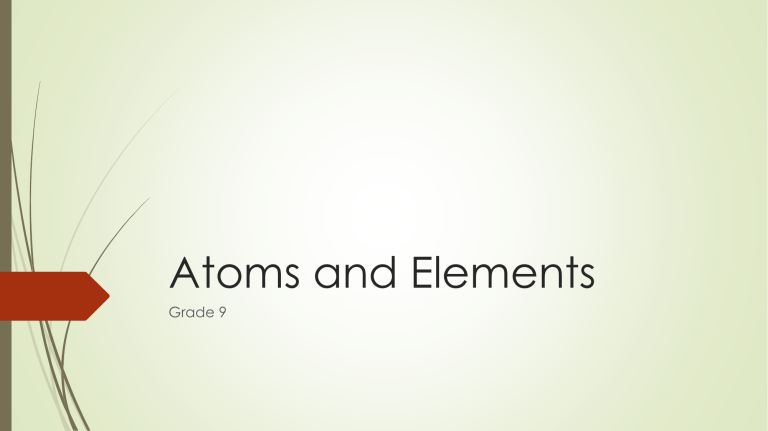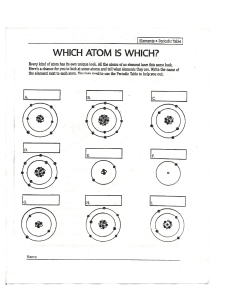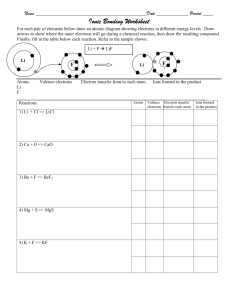
Atoms and Elements Grade 9 What are the relative masses of protons, neutrons and electrons? Proton: 1 Neutron: 1 Electron: 0.00054 What are the relative charges of protons, neutrons and electrons? Proton: +1 Neutron: 0 Electron: -1 Why do atoms contain equal numbers of protons and electrons? Atoms are stable with no overall charge. Protons have a relative charge of +1 and electrons have a relative charge of -1 so there must be an equal number for the charges to balance. What does atomic number represent? The number of protons in an atomic nucleus. What does the mass number of an atom mean? The total number of protons and neutrons found in the nucleus of an atom. How are elements arranged in the modern periodic table? In order of increasing atomic number. Elements with similar properties are in the same group (column). Why do elements in the same group have similar chemical properties? Elements in the same group have the same number of electrons in the outer shell which determines how they react. What does the period (row) number tell you about all the elements in that period? They have the same number of electron shells e.g. all elements in period 4 have 4 shells of electrons. What are isotopes? Atoms of an element with the same number of protons but a different number of neutrons. Isotopes of an element have the same atomic number but different mass numbers. Why do isotopes have the same chemical properties? Because they have the same number of electron in their outer shell so they react in the same way. What are the two types of isotope? Radioactive and non-radioactive Give a medical use of radioactive isotopes Tracers Cancer treatment Lung imaging Anemia diagnosis Give one industrial use of radioactive isotopes Smoke alarms Tracer (e.g. to find leaks in pipes) Sterilisation How are electrons arranged in an atom? In shells around the nucleus. The maximum number of electrons in the first three shells is 2, 8, 8. The first shell can hold two electrons and the second and third can hold eight. What is the most stable electron configuration? A full outer shell of electrons. For the first three shells this is either (2), (2,8) or (2,8,8). Atoms react in order to gain a full outer shell of electrons so that they become more stable. Write the electronic configuration of 1. Rubidium 37 (Rb) 2. Calcium 20 (Ca) 3. Aluminium 13 (Al) 4. Sulfur 16 (S) 5. Strontium 38 (Sr) 6. Bromine 35 (Br) Which group are the noble gases in the periodic table? Group 8 (Also known as group 0) Why are the noble gases very unreactive? The noble gases all have a full outer shell meaning they already have the most stable electron configuration. As a result, they do not react easily. What is the difference between an element and a compound? An element is a substance made up of only one type of atom whereas a compound is made up of two or more chemically combined elements. What is a mixture? Contains two or more elements /compounds which are not chemically combined. What is a metal and where are they found in the periodic table? Metals are found towards the left and bottom of the table. Metals lose electrons to form positive ions. What is a non-metal and where are they found in the periodic table? Non-metals are found towards the top right of the periodic table. Non-metals gain electrons to form negative ions. What are ions? Atoms or groups of atoms with a positive or negative charge. How are ions formed? Positive ions form when an atom loses electrons. Negative ions form when an atom gains electrons. What are cations and anions? Cation - positive ion Anion - negative ion Complete the table Name of elements Atomic number Atomic mass C 6 12 O 8 16 F - 9 19 Ne 10 20 Al 13 27 Cl 17 35 3+ No. of proton No. of electrons No. of neutrons Electronic configuratio n What is valency? In order to write chemical formulae we need to understand how elements combine with each other to form molecules or ionic compounds. Ionic compounds are substances made from the combination of charged ( positive and negative) particles. Valency refers to the ability of an atom or a group of chemically bonded atoms to form chemical bonds with other atoms or groups of atoms. The valency of an element is determined by the number of outer shell (valence) electrons. The valency of polyatomic ions (such as SO42- ) is the charge on the ion. Elements are placed in groups (columns) in the periodic table according to the number of valence electrons, so naturally the position of the element in the periodic table should give us an idea of its valency. All elements in group 1 have 1 valence electron so they have a valency of +1 as they will tend to give up 1 electron. This is the same for group 2 which will give up two electrons and group 3 which will give up 3 electron . Write the chemical formula of the compounds given below: 1. ammonium sulfide 2. sodium nitrate 3. copper(II) bromide 4. aluminum sulfate 5. potassium nitrate 6. Iron (II) carbonate 7. lead(II) phosphate 8. Barium carbonate 9. copper(II) hydroxide 10.calcium fluoride Complete and balance the following chemical equations: Solution: How are ionic bonds formed between group I and group VII elements? Group I elements lose their only outer shell electron to form 1+ ions. Group VII elements have seven electrons in their outer shell and can gain the electron lost from the group 1 element to form ions with a 1- charge. An ionic bond can form between these oppositely charged ions. Draw the dot and cross diagram for sodium chloride What types of elements are ionic bonds formed between? Ionic bonds form between metals and nonmetals. Metal lose electrons to form positive ions. Non-metals gain electrons to become negative ions. Describe the structure of an ionic compound - Giant lattice structure. - Regular alternating arrangement of positive and negative ions. - Held together by electrostatic attraction between oppositely charged ions. What is a covalent bond? A bond formed when two non-metals share a pair of electrons. Why do atoms form covalent bonds? To obtain a more stable electron configuration (full outer shell like the noble gases). Give an example of a compound that contains at least one single covalent bond - H2 (hydrogen) - Cl2 (chlorine) - H2O (water) - CH4 (methane) - NH3 (ammonia) - HCl (hydrogen chloride/hydrochloric acid) How does electrical conductivity compare in ionic and covalent compounds? Except for graphite, covalent compounds are unable to conduct electricity as they have no free charged particles. Ionic compounds conduct electricity when aqueous or molten as in these states, the ions are free to move and carry charge.




